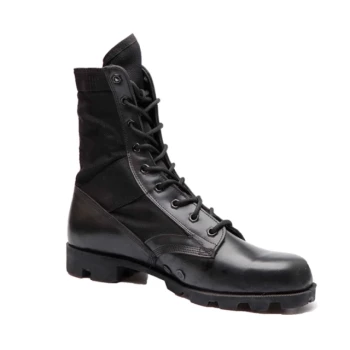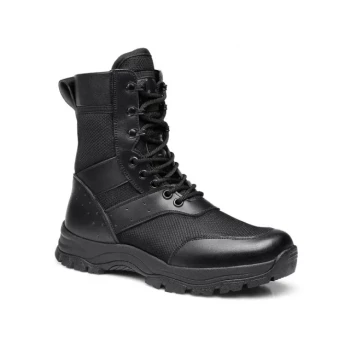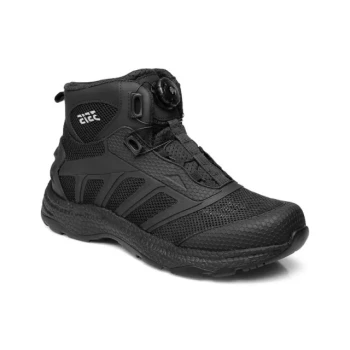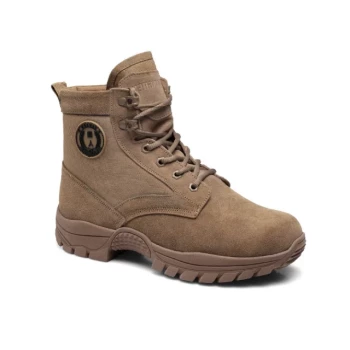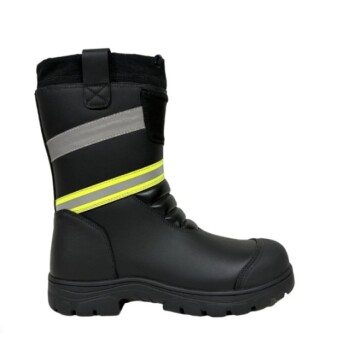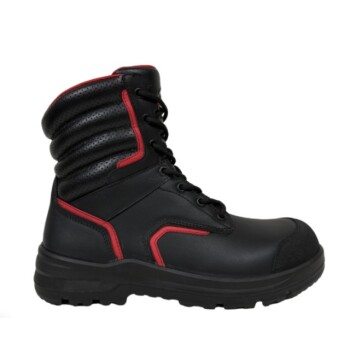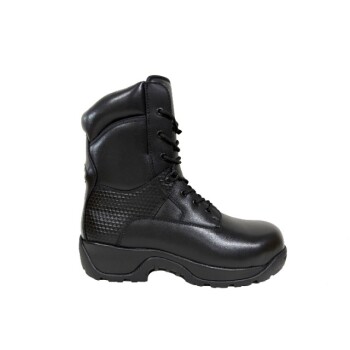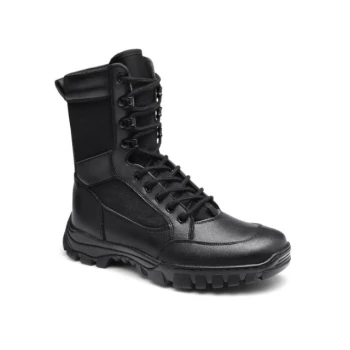Yes, but almost exclusively for ceremonial purposes. The U.S. Army continues to authorize jump boots for wear, but their role has shifted dramatically. They are no longer general-issue combat footwear but are instead a mark of distinction for parachute-qualified soldiers in airborne and special forces units when wearing their dress uniforms.
The iconic paratrooper jump boot has transitioned from a standard piece of battlefield equipment to a powerful symbol of elite status and heritage. Its modern use is reserved for dress and ceremonial occasions, not for combat or field training.
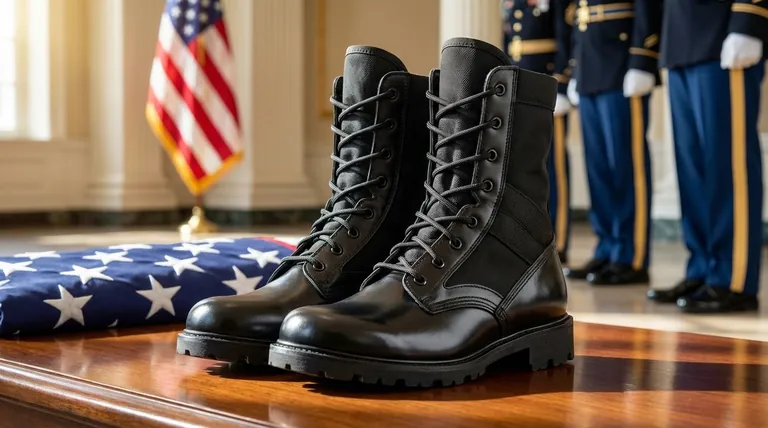
The Modern Role of the Jump Boot
The jump boot's continued presence in the Army is a testament to its symbolic power. It is not a tool for the modern battlefield but a badge of honor connecting soldiers to a proud lineage.
A Mark of Distinction
For a soldier to wear jump boots, they must be parachute-qualified (a graduate of the U.S. Army Airborne School) and assigned to an airborne or special operations unit.
This makes the boots an immediate visual signifier of an elite qualification. They separate paratroopers from other soldiers and are a source of immense pride within the airborne community.
Reserved for Dress and Ceremony
The primary and most visible use of jump boots today is with the Army Service Uniform (ASU), often referred to as "dress blues."
In this context, the boots are meticulously polished to a high shine, serving as a formal uniform item that honors airborne tradition during parades, official ceremonies, and other formal events.
The Shift Away from Combat Use
The reason jump boots are no longer seen in the field is a straightforward matter of technological evolution. Modern military gear prioritizes performance, safety, and durability above all else.
The Rise of Modern Combat Boots
Today's standard-issue Army Combat Boot (ACB) is the result of decades of material science and ergonomic research.
These modern boots offer superior ankle support, more aggressive and specialized tread patterns, and are built from lighter, more breathable, and faster-drying materials than the all-leather jump boots of the past.
Why Jump Boots Aren't Suited for Today's Battlefield
The classic jump boot design, while iconic, is a product of 1940s technology. It lacks the advanced cushioning, support, and durability required for extended operations in harsh, varied terrain.
Fielding them in a modern combat environment would increase the risk of foot and ankle injuries and reduce a soldier's overall effectiveness and endurance.
Understanding the Trade-off: Heritage vs. Performance
The story of the jump boot perfectly illustrates a core tension within any military organization: the need to honor tradition while relentlessly pursuing practical advantage.
The Power of Tradition
The jump boot is an unbreakable link to the legacy of paratroopers from World War II onward. It visually represents the courage of soldiers who jumped from planes into Normandy and Holland.
This powerful symbolism fosters esprit de corps—a sense of shared identity, pride, and commitment that is vital to the effectiveness of elite units.
The Non-Negotiable Need for Performance
When a soldier's life is on the line, function will always supersede form. The military's decision to replace the jump boot for combat use was not a dismissal of its legacy.
It was a practical and necessary decision to equip soldiers with the best possible gear to enhance their safety and operational capability on the modern battlefield.
What the Jump Boot Represents Today
Understanding the jump boot's dual status—ceremonial icon and retired combat tool—is key to understanding modern military culture.
- If your primary focus is on unit identity and tradition: See the jump boot as a cherished and earned symbol of belonging to the exclusive U.S. Army airborne community.
- If your primary focus is on modern combat gear: Recognize that the jump boot was honorably retired from field use, replaced by technologically superior footwear designed for the demands of 21st-century warfare.
Ultimately, the jump boot's journey from the battlefield to the parade ground shows how an effective military honors its past while equipping its soldiers for the future.
Summary Table:
| Aspect | Jump Boots (Past) | Modern Combat Boots (Present) |
|---|---|---|
| Primary Use | General-issue combat footwear | Standard-issue for all field operations |
| Current Role | Ceremonial wear for airborne-qualified soldiers | Daily wear for training and combat |
| Key Features | All-leather construction, iconic design | Advanced materials, superior support, specialized tread |
| Significance | Symbol of heritage and elite status | Optimized for performance, safety, and durability |
Need High-Performance Footwear for Your Operations?
As a large-scale manufacturer, 3515 produces a comprehensive range of durable and technically advanced footwear for distributors, brand owners, and bulk clients. Our production capabilities encompass all types of tactical, safety, and outdoor boots designed to meet the demanding standards of modern use.
Contact us today to discuss your specific needs and discover how we can deliver the reliability and quality your customers depend on.
Visual Guide
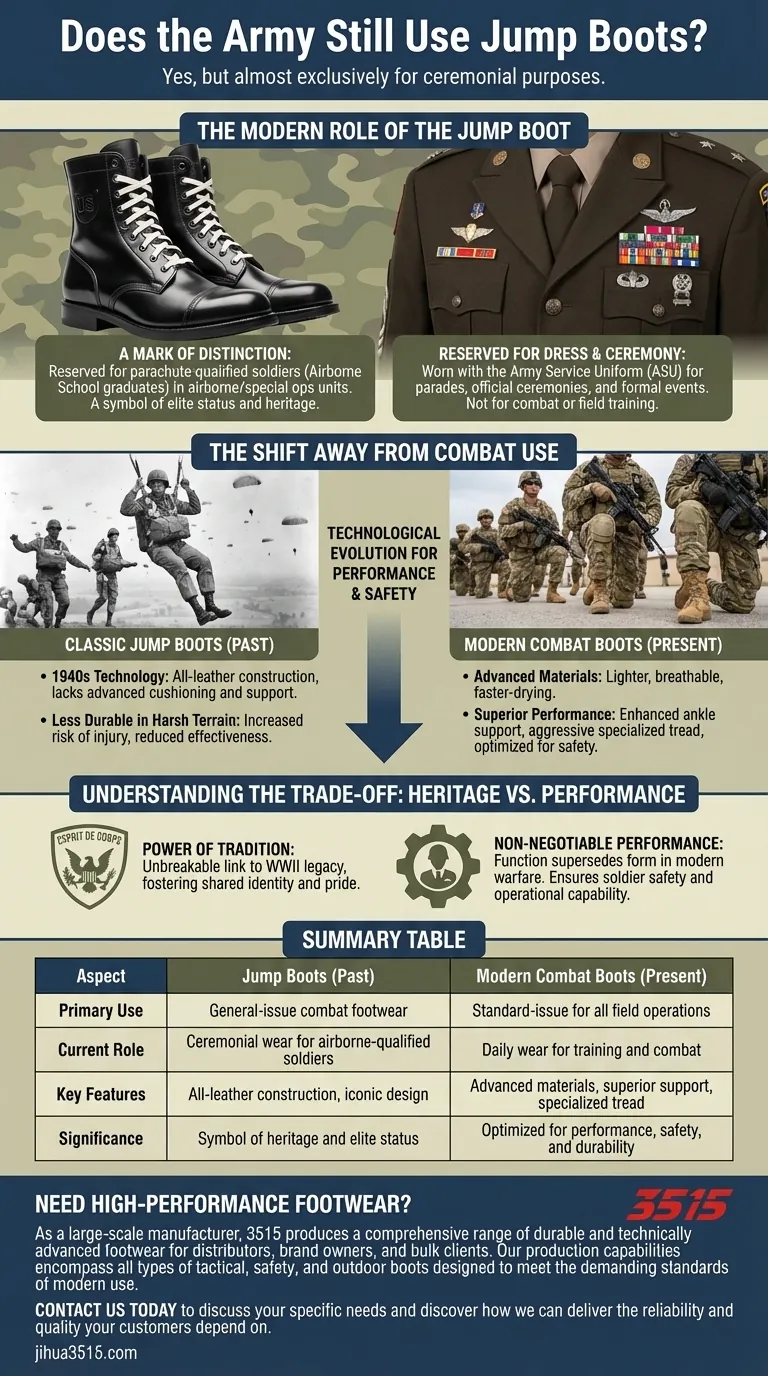
Related Products
- Durable Military Combat Boots with Water Drainage for Wholesale & OEM
- Durable Leather Tactical Boots Wholesale & Custom Manufacturing for Brands
- Wholesale Waterproof Tactical Boots Custom Suede & High-Traction Soles
- Durable Leather High-Ankle Tactical Boots for Wholesale & Custom Manufacturing
- Wholesale Lightweight Tactical Boots with Dial Closure OEM & Bulk Orders
People Also Ask
- What has been the global recognition of fabric for over 30 years? Industry's Trusted Benchmark for Durability
- What are military boots designed for? Unmatched Durability & Protection for Extreme Conditions
- How do tactical boots and combat boots compare in breathability? Tactical Boots Offer Superior Airflow
- What are the limitations of combat boots? Understanding the Trade-offs of Rugged Footwear
- How can a shiny finish be achieved on military boots? A Step-by-Step Guide to a Mirror Shine
